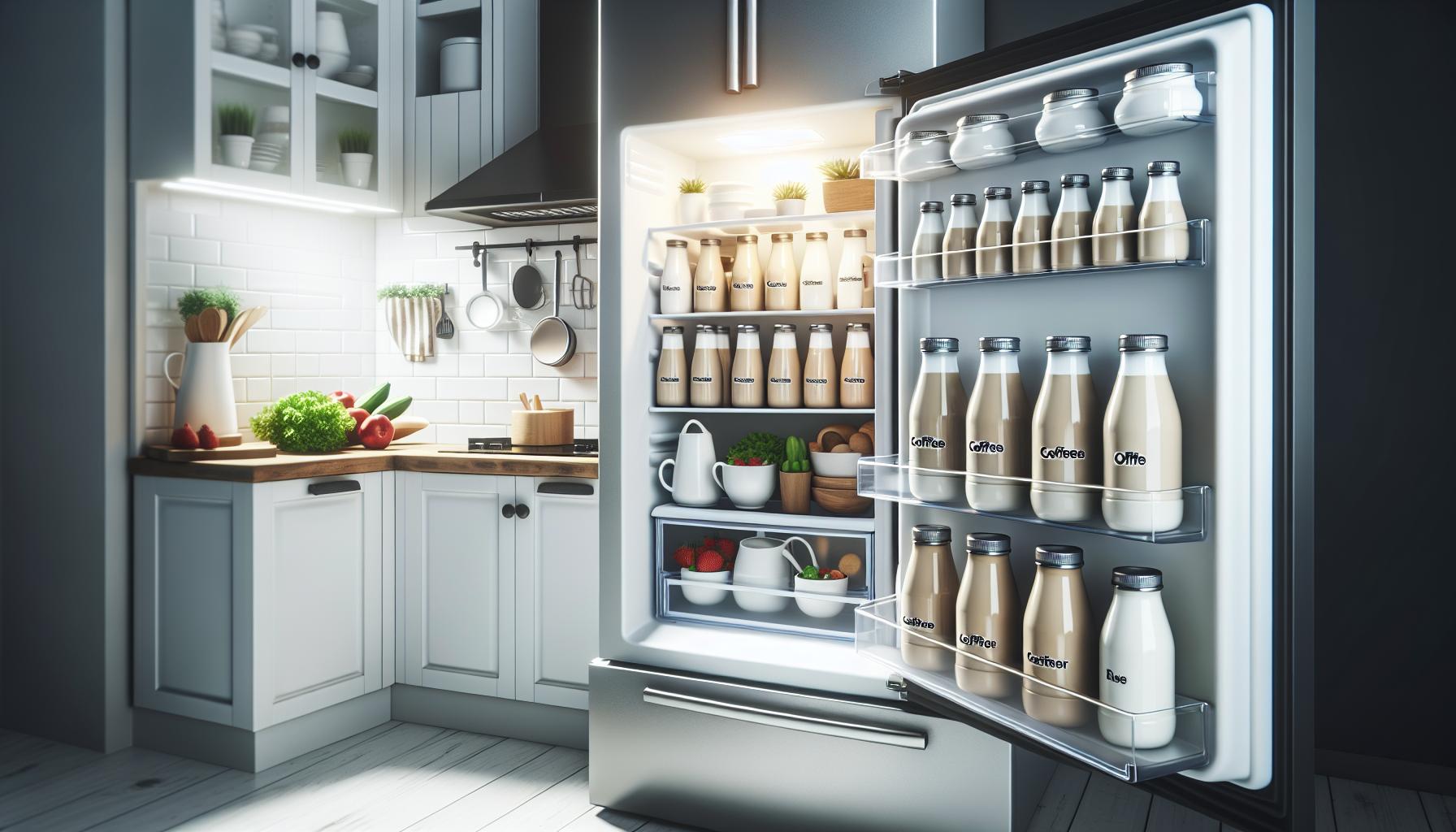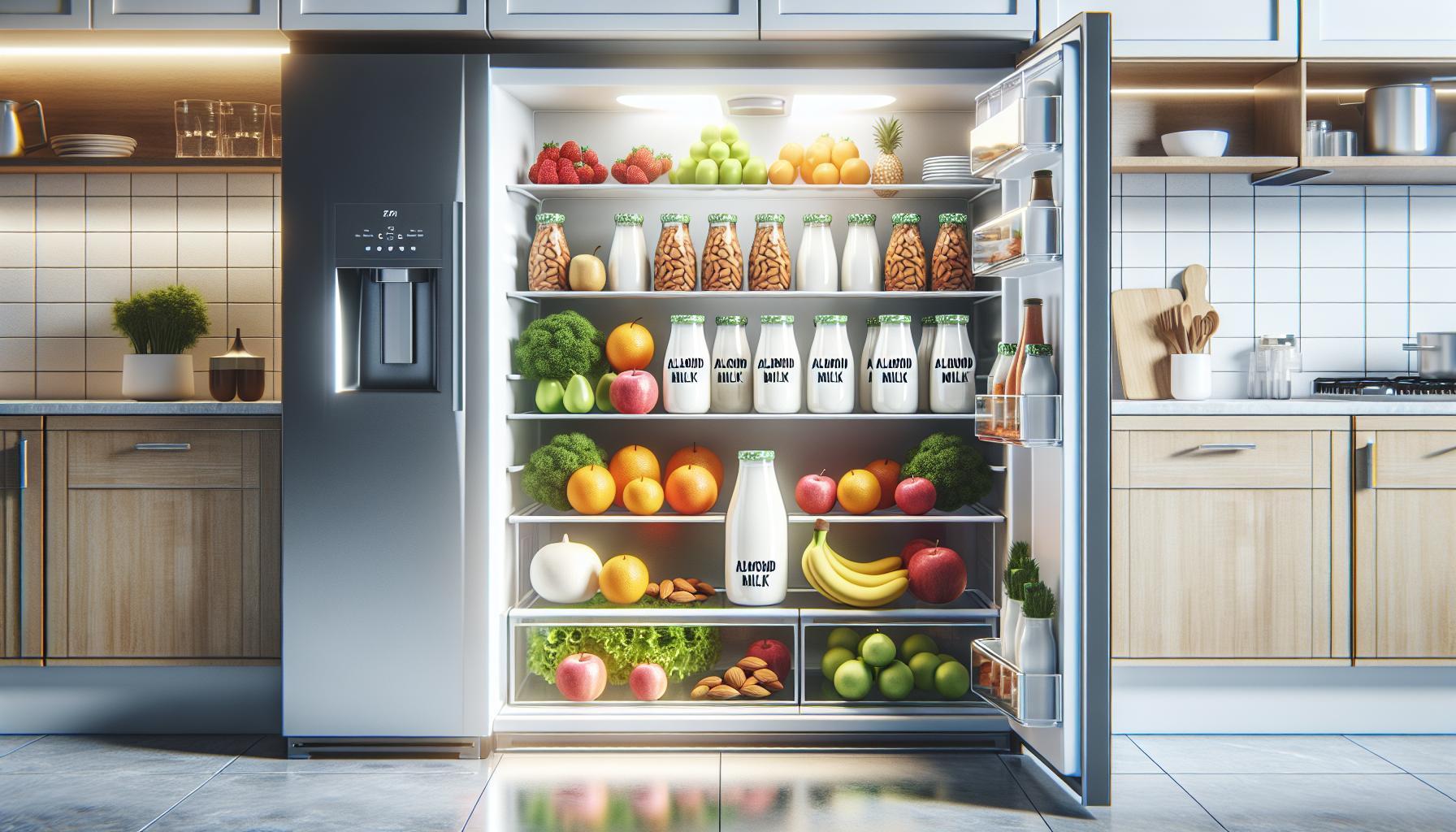Did you know that improper storage of coffee creamer can lead to spoiled sips, impacting your morning routine? Understanding how long coffee creamer lasts in the fridge is essential for maximizing freshness and flavor. Whether it’s a rich dairy creamer or a flavorful non-dairy alternative, knowing the shelf life helps prevent waste and ensures you enjoy every cup.
Many coffee lovers face the dilemma of how to store their creamer properly to avoid unpleasant surprises. Spoiled creamer not only alters the taste of your favorite brew but can also lead to potential health risks. This article delves into the storage guidelines and expiration timelines for various types of creamers, providing you with clear, actionable steps to maintain the quality of your coffee companions. Before you pour another cup, let’s explore how to keep your creamer fresh and safe!
How Long Does Coffee Creamer Last?

The shelf life of coffee creamer can greatly affect your morning routine. Generally, the longevity of your coffee creamer depends on whether it’s dairy-based or non-dairy, as well as how it’s stored. After opening, dairy creamers typically last between 1 to 2 weeks in the refrigerator, while non-dairy creamers can last up to a month when properly sealed. Unopened creamers, whether dairy or non-dairy, can be stored in the fridge effectively until their expiration date, which is often about 6 months to a year from the manufacturing date.
To ensure the best quality and taste, always check the expiration dates and observe changes in texture, color, or smell. If you’re unsure, a quick sniff or taste test (in small amounts) can help you determine if the creamer is still good. Remember to keep the creamer tightly sealed and stored in the coldest part of the refrigerator, as the door tends to fluctuate in temperature more than other areas.
It’s vital to note that both dairy and non-dairy creamers can develop off flavors or spoil due to exposure to air, light, or temperature fluctuations. Therefore, practicing good storage habits not only maximizes the freshness of your creamer but also helps avoid unexpectedly spoiled sips that could ruin your coffee experience.
Signs Your Coffee Creamer Has Spoiled

Creamers are a beloved addition to countless coffee rituals, but knowing when they’ve spoiled is crucial to avoiding unpleasant surprises in your cup. Spoiled coffee creamer can negatively impact not only the taste of your drink but also your health. Whether your creamer is dairy or non-dairy, recognizing the signs of spoilage can save you from an unpleasant morning.
One of the most telltale signs is a change in odor. Fresh creamers typically have a pleasant, creamy scent. If your creamer gives off an off-putting or sour smell, it’s advisable to discard it immediately. Additionally, texture plays a significant role. Creamers should have a smooth, liquid consistency. If you notice clumps, separation, or a thickened texture that wasn’t there before, these are clear indicators that your creamer has gone bad. Pour a small amount into a glass; if it does not flow smoothly or appears curdled, it’s best to toss it.
Another critical factor to consider is the expiration date on the packaging. While some creamers may still be usable past this date, they do not guarantee freshness, especially once opened. After opening, dairy creamers last about 1 to 2 weeks in the refrigerator, while non-dairy versions can last a month if properly sealed. It’s wise to combine the use of expiration labels with your sensory checks-sight and smell can often detect spoilage even before the date has passed.
In short, trusting your senses is essential when evaluating your coffee creamer. A careful examination of odor, texture, and adherence to expiration dates will help ensure your coffee remains a pleasant part of your morning routine, free from the risk of spoiled sips. Always err on the side of caution-if in doubt, it’s better to discard than to risk your health with questionable creamer.
Tips for Storing Coffee Creamer Safely

When it comes to enjoying your morning coffee, the creamer you choose plays a significant role in flavor and texture. To maintain the freshness of your coffee creamer and to ensure it lasts as long as possible, effective storage practices are essential. Start by keeping your creamer in its original container and always seal it tightly after each use. This helps prevent exposure to air, which can lead to spoilage.
It’s vital to store creamer in the coldest part of your refrigerator, typically towards the back, rather than in the door where temperatures fluctuate. Keep an eye on the temperature setting of your fridge, ensuring it stays below 40°F (4°C). Additionally, try to avoid leaving creamer out at room temperature for extended periods; if it’s been out for more than two hours, it’s safer to discard it. For those who appreciate variety, consider purchasing smaller containers of different types of creamers to minimize waste while ensuring freshness.
For flavored creamers, their sugars and additives can sometimes alter preservation timelines. Be sure to check the specific expiration date on these bottles as they may differ from standard creamers. Labeling your opened creamers with the date they were opened can help you track their usage more effectively, reminding you to consume them within the recommended timeframe.
Lastly, remember that some creamers are made to be shelf-stable until opened. For these, store them in a cool, dark place. Once opened, transition to refrigerator storage. Keeping these tips in mind will not only enhance your coffee experience but will also ensure that your creamer remains safe and delicious for as long as possible.
Differences Between Types of Creamers
Coffee creamers are diverse in composition and flavor, and understanding these differences is essential for maximizing freshness and safety. The type of creamer you choose can significantly impact how long it lasts in your refrigerator and how you should store it.
One of the most common distinctions among creamers is between dairy-based and non-dairy options. Dairy creamers, made from milk or cream, typically have a shorter shelf life and can spoil quickly if not stored properly. Generally, opened dairy cream can last about 1-2 weeks in the fridge, while unopened containers may last up to a month past the printed expiration date if stored correctly. Non-dairy creamers, often derived from almond, soy, or coconut, have the advantage of being shelf-stable before opening. Once opened, however, they still require refrigeration and typically last about 2-3 weeks.
Flavored creamers introduce another layer of complexity. The addition of flavors and sugars not only enhances taste but may also affect stability. These creamers often contain preservatives, which can extend their shelf life slightly, but it’s crucial to check expiration dates. Generally, flavored creamers should be consumed within 1-3 weeks after opening for optimal flavor and safety, so watch for any signs of spoilage, like changes in smell or texture.
In addition to composition, it’s important to consider the method of processing. Liquid creamers are commonly used in households and need strict refrigeration guidelines-exposing them to room temperature can significantly shorten their shelf life. Powdered creamers, while more stable at room temperature, should be kept tightly sealed in a cool, dry place and used within a few months of opening. These can last longer, sometimes up to 6-12 months, but it’s always wise to check for clumping or off-smells before using.
By being mindful of these differences, you can better manage your coffee creamer selection and storage, ensuring that you enjoy every sip without the worry of spoiled product.
Freezing Coffee Creamer: Is It Safe?
Freezing coffee creamer is a practical and often overlooked solution for extending its shelf life, but it comes with specific considerations to ensure both safety and quality. Many people may not realize that both dairy and non-dairy creamers can be frozen, and this can effectively prevent waste when you find a great deal or have a few too many opened containers.
When freezing coffee creamer, it’s crucial to use airtight containers or resealable freezer bags. This minimizes air exposure and prevents freezer burn, which can alter the taste and texture of the creamer. To do this effectively, consider the following steps:
- Portion Control: Divide the creamer into smaller quantities before freezing. This allows you to thaw only what you need, maintaining the quality of the rest.
- Labeling: Label containers with the type of creamer and the date of freezing. This will help you keep track of how long it’s been stored.
- Thawing: When ready to use, thaw the creamer in the refrigerator overnight. Avoid hot water or microwave methods, as these can cause texture changes.
While freezing can help increase creamer longevity, there are some caveats to keep in mind. Upon thawing, the consistency of the creamer may separate or become grainy, especially for dairy-based varieties. A good shake or stir usually remedies this, but it’s wise to use the thawed creamer within a week for the best flavor. For satisfying consistency, consider blending well after thawing.
Generally, frozen coffee creamer can last in the freezer for up to 3-6 months. However, flavor may diminish over time, so utilize it sooner rather than later for optimal taste. In summary, freezing coffee creamer can be a safe and effective method for prolonging its use, allowing you to enjoy your favorite cup of coffee without the worry of spoilage.
What to Do with Expired Creamer
Using expired coffee creamer can be a gamble, but knowing how to handle it can help you make the right choice. If you discover that your coffee creamer has passed its expiration date, start by inspecting it closely. Look for signs of spoilage, which can include an off smell, curdling, or changes in color. If anything seems amiss, it’s best to err on the side of safety and discard it. Although some creamers may still be safe to use shortly after the expiration date, their quality and flavor may be compromised.
If the creamer looks and smells normal, perform a small taste test. Use only a tiny amount in a separate dish-not directly from the original container. If it tastes fine, it may still be usable in cooking or baking where the flavor can blend with other ingredients. Consider incorporating it into recipes that require dairy, such as pancakes, creamy sauces, or baked goods. This can help mask any subtle off-flavors that may have developed.
Always be mindful of the type of creamer in question. Non-dairy creamers typically have a longer shelf life due to preservatives, whereas dairy creamers are more sensitive to time and temperature fluctuations. With dairy creamers, it’s crucial to judiciously monitor their use and storage. If you’re uncertain about the safety of your expired creamer, as a rule of thumb, it’s better to dispose of it than risk foodborne illness.
To minimize waste in the future, consider keeping track of expiration dates or using your creamer consistently within its shelf life. Always store your creamer properly in the fridge, ideally at the back where it’s colder. Following these guidelines ensures that you enjoy fresh, flavorful coffee without the worry of spoiled sips.
Understanding Coffee Creamer Labels
can seem overwhelming, but they are your best resource for ensuring both safety and quality in your daily brew. The label provides vital information about the product’s ingredients, storage instructions, and expiration dates, all of which play a crucial role in how long your creamer will last in the fridge. For instance, many creamers contain preservatives that extend shelf life, particularly non-dairy options. Familiarizing yourself with these terms can help you make more informed choices and avoid spoiled sips.
One of the first things to look for on the label is the expiration date. This date indicates when the product is expected to maintain its best flavor and quality. Typically, dairy creamers have a shorter shelf life-often around one to two weeks after opening-while non-dairy creamers can last significantly longer, sometimes up to a month or more if unopened. Additionally, pay attention to whether the creamer is labeled as “ultra-pasteurized,” which means it has been heated to a high temperature to kill bacteria, thus extending its lifespan.
Another important aspect is the list of ingredients. A shorter list with recognizable ingredients is usually a safer bet. Artificial flavors and additives can sometimes compromise the creamer’s freshness and taste over time. If you’re avoiding certain ingredients due to allergies or dietary restrictions, this ingredient list will also help you choose the right product.
Lastly, keep in mind any storage instructions indicated on the label. Many creamers need to be kept refrigerated after opening, and ensuring they stay at a stable, cool temperature will help retain their freshness. Always store the creamer in the coldest part of your fridge, typically towards the back, instead of the door, where temperature fluctuations can occur. By understanding these key components of coffee creamer labels, you can enjoy your coffee with confidence, free from the worry of spoiled creamer.
Best Practices for Using Leftover Creamer
Using leftover coffee creamer can be both economical and practical, but it’s essential to do so wisely to avoid any unpleasant surprises. If you’re looking to get the best from your creamer while maintaining safety, there are several best practices to consider.
First, always check the expiration date and freshness before using any leftover creamer. If the creamer is past its expiration date or you notice any changes in texture, color, or smell, it’s best to discard it. Even if the date hasn’t passed, a simple visual and olfactory inspection can save you from a spoiled sip. If the creamer is still good, consider how to incorporate it into your routine.
To maximize usage, consider pouring leftover creamer into smoothie recipes, incorporating it into baking-like in pancakes or muffins-or even using it as a flavor enhancer in sauces or soups. Mixing it into coffee, teas, or protein shakes can provide added richness and flavor. If you’re cautious about using it before it spoils, set aside a designated day each week to finish off any remaining creamer.
If you find yourself consistently left with creamer nearing its expiration, you might want to explore smaller-sized containers or single-serve options to avoid waste. Additionally, if your brand of creamer allows for freezing, consider freezing small portions in ice cube trays. These can be used later in recipes or for coffee on-the-go, extending the shelf life beyond conventional refrigerated limits. Just remember to thaw it in the refrigerator before transferring it to your coffee for best results.
By being vigilant and creative with your remaining creamer, you can enjoy all its rich flavors while minimizing spoilage and waste, ensuring your coffee experience remains delightful.
Common Myths About Coffee Creamer Storage
Myths about coffee creamer storage can lead to unexpected spoilage and wasted ingredients, which no coffee lover wants to face. One common belief is that all creamers can be stored indefinitely at room temperature. In reality, while some non-dairy creamers are shelf-stable before opening, once opened, they should be refrigerated. Most dairy creamers have a limited shelf life and must be kept cold to maintain freshness and prevent spoilage.
Another misconception is that freezing coffee creamers can ruin their texture and flavor. While it’s true that some brands and types may not fare well in the freezer, many creamers actually freeze quite well when portioned into ice cube trays. This method allows you to use only what you need while extending their shelf life. Just remember to thaw them in the refrigerator before use to maintain quality.
Storage outside of the fridge is also often thought to be harmless if the creamer has not reached its expiration date. However, consistent exposure to warmer temperatures can accelerate spoilage. Always check for signs of spoilage, such as a sour smell or changes in consistency, regardless of the sell-by date.
Lastly, many believe that pasteurized creamers are immune to bacterial growth if kept within their expiration dates. However, once opened, they can still be susceptible to contamination. To ensure safety, limit exposure to air, avoid using unclean utensils, and consume within a week or two after opening depending on the specific product’s guidelines. Following these practices will help keep your coffee experience enjoyable and your creamer fresh.
How to Maximize Creamer Freshness
To keep your coffee creamer fresh and flavorful for as long as possible, it’s essential to adopt a few strategic storage methods that can make a significant difference in its shelf life. After opening, most creamers, whether dairy or non-dairy, require refrigeration to prevent spoilage and maintain quality. Generally, a well-stored coffee creamer can last about 1-2 weeks after its indicated expiration date if kept consistently chilled.
One effective approach is to minimize air exposure. Airborne bacteria can hasten spoilage, so always close the container tightly after each use. For added protection, you might consider transferring your creamer to a glass or plastic container with a secure lid, especially if the original packaging is flimsy or prone to leaking air.
Furthermore, setting your refrigerator to the appropriate temperature-ideally below 40°F (4°C)-is crucial. This range ensures the optimum cold environment for preserving the freshness of your creamer. If you’ve opened multiple creamers, keep the oldest ones at the front of the fridge to use them first. It’s also wise to avoid storing creamer in the fridge door, where temperature fluctuations are common due to frequent opening and closing.
Regularly inspecting your coffee creamer can prevent unpleasant surprises. Get into the habit of checking for signs of spoilage, such as an off smell, strange consistency, or changes in color. If you notice any of these indicators, it’s best to discard the creamer rather than risk consuming spoiled products.
By implementing these proactive storage tips, you can enjoy your coffee creamer’s delightful flavor without the worry of unexpected spoilage, ensuring that every cup of coffee remains a pleasurable experience.
Frequently Asked Questions
Q: How can I tell if my coffee creamer is bad?
A: Check for signs like an off smell, changes in color or texture, or lumps. If the creamer tastes sour or has a rancid flavor, do not consume it. Refer to the “Signs Your Coffee Creamer Has Spoiled” section for detailed indicators.
Q: Can coffee creamer go bad if left out overnight?
A: Yes, coffee creamer can spoil if left out overnight. Dairy-based creamers should not exceed two hours at room temperature. Always refrigerate promptly to maintain freshness and safety. Refer to the “Tips for Storing Coffee Creamer Safely” section for more information.
Q: What is the shelf life of unopened coffee creamer?
A: Unopened coffee creamer can last several months beyond the printed date if stored properly. However, once opened, dairy creamers generally last about 1-2 weeks. Check the “How Long Does Coffee Creamer Last?” section for specific timeframes based on the type of creamer.
Q: Is it safe to use coffee creamer past its expiration date?
A: While some coffee creamers may still be safe to use shortly after the expiration date, it’s crucial to check for spoilage signs. If it looks, smells, or tastes off, discard it. Refer to the “What to Do with Expired Creamer” section for further guidance.
Q: Can I freeze coffee creamer to extend its shelf life?
A: Yes, you can freeze coffee creamer to prolong its life. However, the texture may change once thawed, making it best used in cooking or baking. Check the “Freezing Coffee Creamer: Is It Safe?” section for tips on proper freezing techniques.
Q: How should I store opened coffee creamer to keep it fresh?
A: Store opened coffee creamer in the refrigerator promptly after use. Keep it sealed tightly to prevent exposure to air and odors. For specific storage tips, see the “Tips for Storing Coffee Creamer Safely” section.
Q: Are there healthier alternatives to traditional coffee creamers?
A: Yes, options like almond milk, oat milk, or coconut milk provide lower-calorie and dairy-free alternatives. Consider exploring the “Differences Between Types of Creamers” section for more comparisons and insights on various options.
Q: What is the best way to use leftover coffee creamer?
A: Leftover coffee creamer can be added to recipes such as pancakes, soups, or desserts for extra flavor. Always ensure it is still fresh before use. Refer to the “Best Practices for Using Leftover Creamer” section for creative ideas.
Insights and Conclusions
To ensure your coffee creamer stays fresh and delicious, remember the important guidelines on storage and shelf life discussed in this article. Always check expiration dates and store your creamer properly in the fridge to avoid any spoiled sips. If you’re still unsure about your creamer’s freshness, a quick smell or taste test can be helpful in making informed decisions.
For even more tips on food safety, explore our articles on “Best Practices for Food Storage” and “How to Tell if Dairy Products are Spoiled.” Don’t forget to subscribe to our newsletter for the latest food safety insights directly to your inbox! Your coffee breaks deserve the best-take action today to keep your creamer fresh and reduce waste. Join the conversation and share your experiences with us; your feedback could help others!





